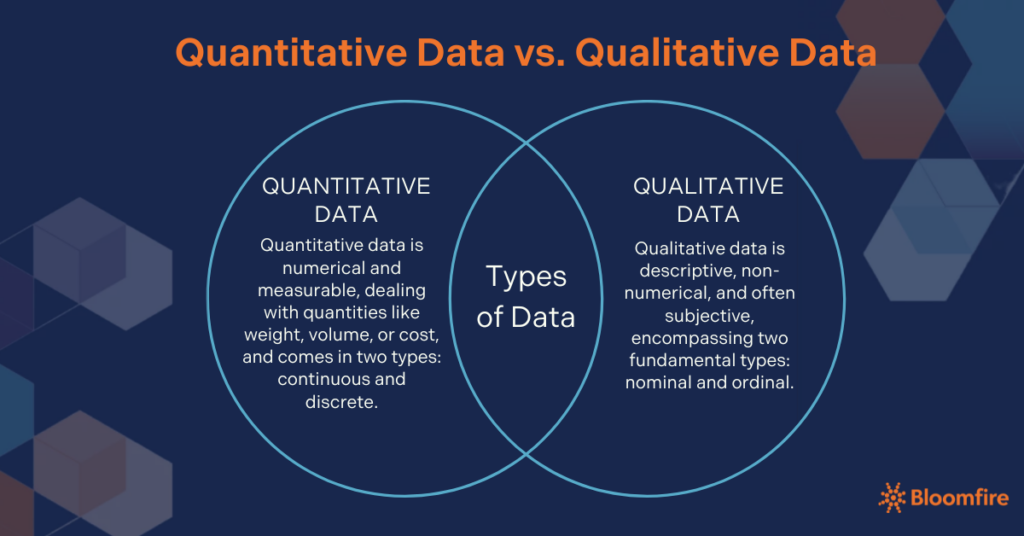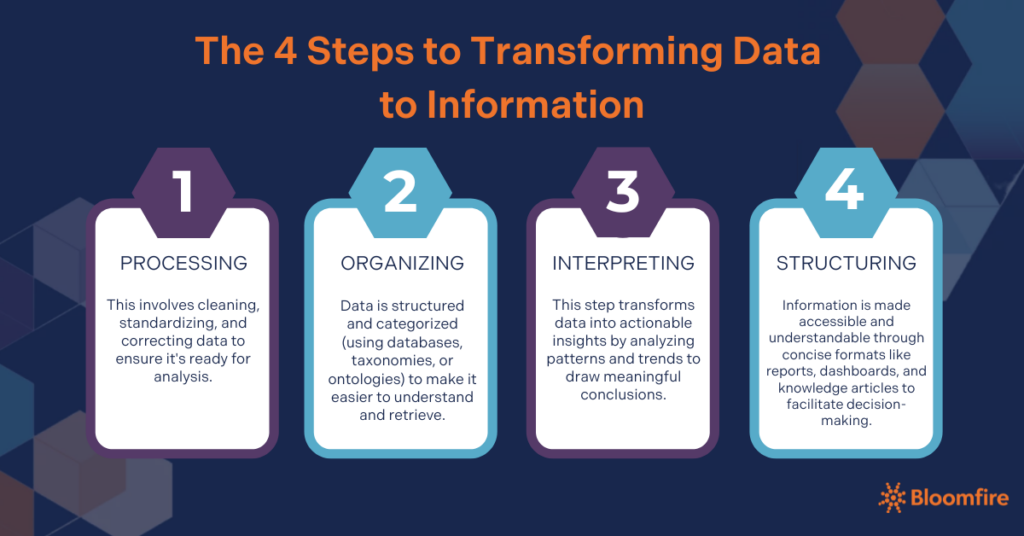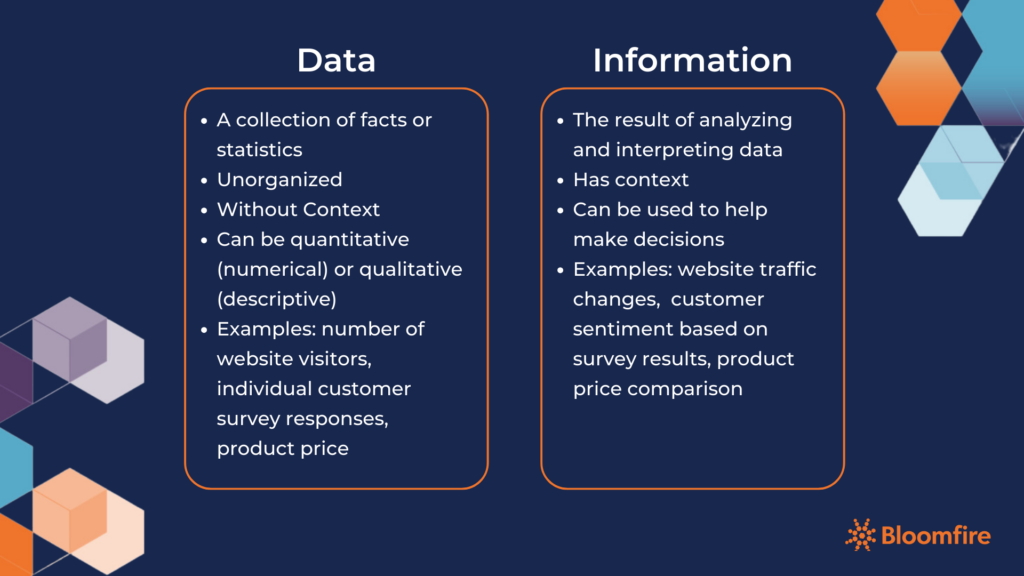What is Data vs. What is Information

Understanding the distinction between data and information allows businesses to better organize their knowledge, especially in today’s digital landscape. Data comprises raw, unprocessed facts that need context to become useful, while information is data that has been processed, organized, and interpreted to add meaning and value. This transformation from raw data to meaningful information is the foundation of knowledge management, enabling businesses to make informed decisions and gain a competitive edge.
What Is Data?
Data represents raw elements or unprocessed facts, from numerical values and symbolic representations to textual content and visual imagery. When collected and observed without interpretation, these elements remain mere data points—discrete and disorganized entities lacking inherent meaning or significance.
However, when these pieces are analyzed and contextualized, they yield actionable insights and knowledge. This process of refinement and interpretation unlocks the actual value of data and enables informed decision-making.
Data comes in various forms. Specifically, it can be categorized into two categories: quantitative and qualitative data.
1. Quantitative data
This data type is numerical and measurable, dealing with quantities and values that can be expressed mathematically, like an item’s weight, volume, or cost. The two types of quantitative data are:
- Discrete data involves finite values that can be counted, often represented by whole numbers. Examples of discrete data include the number of items in a shipment or the number of attendees at an event.
- Continuous data represents values infinitely subdivided within a range, offering precise measurements for attributes like height, weight, temperature, and duration.
2. Qualitative data
This type is descriptive and non-numerical, focusing on qualities and attributes that cannot be measured with numbers. It’s often subjective and interpretive. There are two fundamental types of qualitative data.
- Nominal data classifies elements into distinct categories where no ranking or order is implied, such as gender and nationality.
- Ordinal data establishes a ranked order of categories, indicating relative position without specifying the exact distance between them. Examples of such data are education level (high school, bachelor’s, master’s) and customer satisfaction ratings (very satisfied, satisfied, neutral, etc.).

Data is the unmilled element that fuels the engine of knowledge discovery. Understanding the nature and various data types empowers organizations to transform data from simple facts and figures into powerful tools for effective knowledge management. On the other hand, unused data, also dubbed dark data, can incur additional costs for the company, especially since about 55% of such data is obscure and completely untapped.
Did You Know? Digital data for enterprise intelligence has two forms: structured and unstructured data. Structured data is organized and easily searchable in relational databases, while unstructured data lacks a predefined format and is typically stored in its native form.
Supercharge Your Data AI-Readiness
Get accurate, AI-ready data in Bloomfire with powerful integrations and real-time content checks.
Learn More
What Is Information?
You get information when data is processed, organized, interpreted, and structured. The comprehensible output derived from raw data helps inform decisions, strategies, and actions. Information is data made valuable and accessible—an integral component of decision-making.
For instance, if data points include daily temperature readings over a year, information is recognizing the trend of temperatures, understanding seasonal changes, and predicting future weather conditions.
Converting data to information involves the following steps:
- Processing: This involves cleaning and preparing data for analysis. It might include removing duplicates, correcting errors, and converting data into a standardized format.
- Organizing: Data is structured and categorized to facilitate understanding and retrieval. This could encompass creating databases, taxonomies, or ontologies.
- Interpreting: This step refines data into actionable insights by uncovering patterns, trends, and relationships. This process often utilizes statistical analysis, effective data visualization, and expert knowledge to derive meaningful conclusions.
- Structuring: Finally, information is presented concisely and is accessible. This could involve creating reports, dashboards, knowledge articles, or other formats that facilitate understanding and decision-making.

What Is the Difference Between Data and Information?
Information becomes a dynamic resource that empowers individuals and organizations within a knowledge management system. Therefore, in data vs. information, both forms of knowledge are critical versions of insights that drive decision-making. In addition, with today’s digital landscape, data is not simply converted to general information but to a type and quality that supports machine learning.
The evolution from data to information is fundamental in harnessing the potential of business analytics and involves several key distinctions. In its original form, data is raw and often chaotic, lacking meaningful structure or context. On the other hand, information is the refined, analyzed, and structured output derived from this data, tailored to provide actionable insights and facilitate strategic decision-making.
The journey from data to information involves several key distinctions:
- Data is raw and unstructured, like individual customer interactions or transaction logs. On the other hand, information provides context and insights, like a trend analysis that shows increasing customer satisfaction or sales figures over time.
- Data is often abundant and readily available, but it can be overwhelming without interpretation. Meanwhile, information that is curated and usable offers strategic insights to guide business decisions.

Examples of Data vs. Information in Business
Raw data, such as the number of website visitors or customer purchase histories, is the building block, but converting this data into information fuels business success. Businesses can extract valuable insights from this raw data through analysis and interpretation, such as identifying trends, understanding customer behavior, and predicting future outcomes.
This information empowers businesses to make informed decisions, optimize operations, and develop strategies that drive growth and achieve objectives.
Data Examples
Businesses today thrive on data, using it to fuel strategies and optimize operations. From understanding customer behavior to predicting market trends, data manifests itself in the business landscape in various ways.
- Employee demographics and salary information
- Revenue figures and cash flow statements
- The number of visitors to a website in one month
- Inventory levels in a warehouse on a specific date
- Production output, defect rates, and delivery times
- Individual satisfaction scores on a customer service survey
- The number of support tickets and call logs
- The price of a competitor’s product
- Social media engagement metrics (number of likes, shares, and comments)
Did You Know? Gartner predicts that nearly all data-driven decisions will involve some level of automation, driven by AI and decision intelligence, by 2025. This shift towards automated decision-making allows organizations to make faster, more complex, and finely-tuned choices, giving them a competitive edge.
Information Examples
Every successful business decision starts with reliable, relevant information. That said, here are some examples of information in computer work and businesses that influence process optimization.
- Customer segmentation based on purchase history
- Predictive maintenance scheduling
- Profiles of ideal customers based on aggregated data from various sources
- Understanding that changes to a website have led to an increase or decrease in monthly site visitors
- Identification of supply chain issues based on trends in warehouse inventory levels over time
- Finding areas for improvement in customer service based on a collection of survey responses
- Determining if a competitor is charging more or less for a similar product
It’s important to note that information vs. data depend on one another. However, their relationship must be established through a refined process that ensures data quality (especially for artificial intelligence) and information with the highest value. Bridging the gap between the two requires consistent and quality knowledge management practices. In turn, it empowers organizations to transform data into actionable insights that drive strategic decision-making.
How Businesses Can Leverage Data and Information
Differentiating data from information is more than an academic exercise—it’s a strategic necessity. Businesses that excel in converting data into feasible information can enhance decision-making, optimize operations, and drive growth.
For example, analyzing customer data to understand buying patterns and preferences can lead to more effective marketing strategies, tailored product offerings, and improved customer satisfaction. This strategic use of information can significantly impact a company’s bottom line.
Another scenario is when businesses analyze customer feedback and support interactions to identify pain points and improve service quality. For instance, a telecommunications company uses data to identify common customer complaints and proactively addresses them through frequently asked questions (FAQs) and improved service processes.
Furthermore, organizations can identify bottlenecks and inefficiencies in internal processes through data analysis and workflow optimization. Say a manufacturing company uses data to track production line performance and identify areas for improvement, reducing waste and improving efficiency. This action may lead to crucial information influencing employee training and productivity software acquisition.
The Role of Knowledge Management in Maximizing Data and Information
Many organizations struggle to create a data-driven culture, often hindered by outdated or disparate information systems. This is where knowledge management platforms play a crucial role.
A reliable big data and knowledge management strategy helps organize and structure data, making it easier to find and understand. It also adds context to data, connecting it to relevant information and expertise within the organization.
In addition, knowledge management systems capture implicit, explicit, and tacit knowledge types and make them accessible to those who need it. By centralizing data and transforming it into accessible and actionable information, these platforms help organizations:
- Streamline decision-making processes
- Ensure data accuracy and reliability
- Improve organizational agility
- Enhance employee engagement (especially in customer service)
- Foster a culture of informed decision-making across all levels of the organization.
Understanding the qualitative benefits of knowledge management further underscores the importance of implementing these systems beyond mere technology solutions. Businesses can effectively convert data into information to enhance decision-making processes, optimize operations, and drive strategic growth.
Moving Toward a Data-Driven Culture
Creating a data-driven culture requires more than just access to data and information. It involves a systematic approach to knowledge management that integrates technology, people, and processes.
It’s valuable to highlight the fine line between information and data, but it’s equally crucial to recognize the difference between technology and knowledge management. While technology provides tools for collecting and analyzing data, knowledge management encompasses a broader strategy that includes organizing, interpreting, and using the data that has evolved into information.
Thanks to the heavy involvement of the right technology and knowledge management methodologies, the transformation process continues to be highly valued in leading organizations. In fact, according to the Survey of Data and Analytics Professionals, 77% of respondents mark data-driven decision-making (DDDM) as their number one priority for their data programs.
However, according to industry research, this endeavor may require extensive work after a streamlined knowledge management implementation, especially as 90% of organizational data often sits idle. This represents a significant untapped resource and a missed opportunity for businesses to gain valuable insights.
Implementing a knowledge management system can help ensure that data is collected and converted into coherent, relevant, and timely information. By adopting a knowledge management platform, organizations can:
- Enhance their operational efficiency
- Foster innovation through better access to comprehensive insights
- Improve customer engagement through data-driven strategies
Power Move: Staying abreast of knowledge management trends allows businesses to adopt cutting-edge tools and strategies for organizing and analyzing data, transforming it into actionable information. This, in turn, drives the achievement of business goals.
Harnessing Data and Information for Strategic Advantage
Understanding their difference is crucial for any organization aiming to leverage its full potential in the context of info vs. data. Businesses can effectively convert data into information to enhance decision-making processes, optimize operations, and drive strategic growth. Mastering this transformation process is critical to creating a proactive, insightful, and competitive business environment.
Embracing a systematic approach to managing and analyzing data will ensure that it transcends its raw state to become meaningful information that propels business success. This approach enhances a company’s operational capabilities and strengthens its capacity to innovate and adapt in an ever-evolving market landscape.
Embrace the Power of Knowledge Management
Discover how a knowledge management system can transform your business by effectively utilizing data and information.
Explore our KM solutions

Enterprise AI Search: Definition, Benefits, and Evolution

The Benefit of Company-Wide Knowledge Management in 2026

Are You Making These Common Knowledge Sharing Mistakes?

Estimate the Value of Your Knowledge Assets
Use this calculator to see how enterprise intelligence can impact your bottom line. Choose areas of focus, and see tailored calculations that will give you a tangible ROI.

Take a self guided Tour
See Bloomfire in action across several potential configurations. Imagine the potential of your team when they stop searching and start finding critical knowledge.